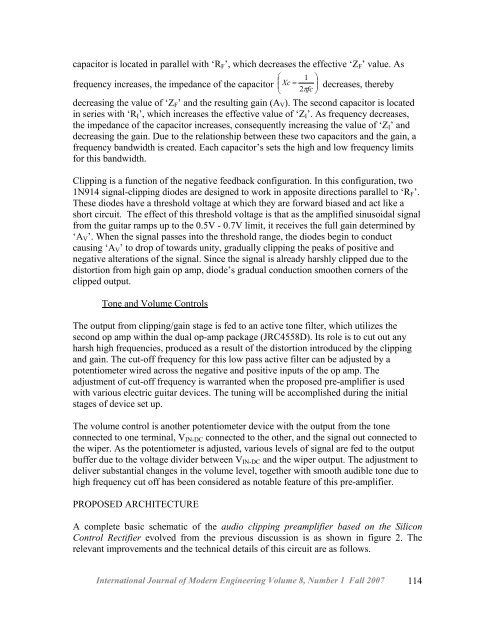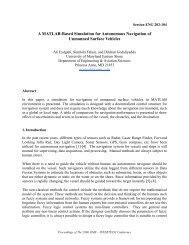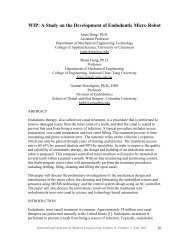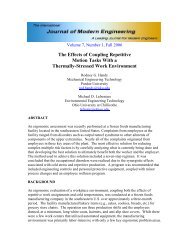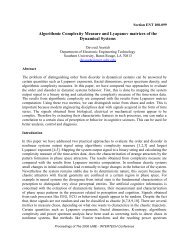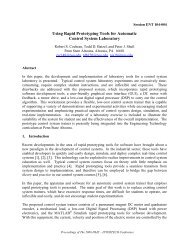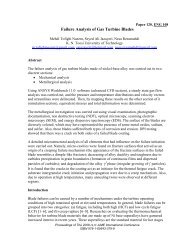A New Design for Audio Clipping Pre-amplifiers Based on ... - IJME
A New Design for Audio Clipping Pre-amplifiers Based on ... - IJME
A New Design for Audio Clipping Pre-amplifiers Based on ... - IJME
Create successful ePaper yourself
Turn your PDF publications into a flip-book with our unique Google optimized e-Paper software.
capacitor is located in parallel with ‘R F ’, which decreases the effective ‘Z F ’ value. Asfrequency increases, the impedance of the capacitor⎛⎜ Xc =⎝12πfc⎟ ⎞⎠decreases, therebydecreasing the value of ‘Z F ’ and the resulting gain (A V ). The sec<strong>on</strong>d capacitor is locatedin series with ‘R I ’, which increases the effective value of ‘Z I ’. As frequency decreases,the impedance of the capacitor increases, c<strong>on</strong>sequently increasing the value of ‘Z I ’ anddecreasing the gain. Due to the relati<strong>on</strong>ship between these two capacitors and the gain, afrequency bandwidth is created. Each capacitor’s sets the high and low frequency limits<str<strong>on</strong>g>for</str<strong>on</strong>g> this bandwidth.<str<strong>on</strong>g>Clipping</str<strong>on</strong>g> is a functi<strong>on</strong> of the negative feedback c<strong>on</strong>figurati<strong>on</strong>. In this c<strong>on</strong>figurati<strong>on</strong>, two1N914 signal-clipping diodes are designed to work in apposite directi<strong>on</strong>s parallel to ‘R F ’.These diodes have a threshold voltage at which they are <str<strong>on</strong>g>for</str<strong>on</strong>g>ward biased and act like ashort circuit. The effect of this threshold voltage is that as the amplified sinusoidal signalfrom the guitar ramps up to the 0.5V - 0.7V limit, it receives the full gain determined by‘A V ’. When the signal passes into the threshold range, the diodes begin to c<strong>on</strong>ductcausing ‘A V ’ to drop of towards unity, gradually clipping the peaks of positive andnegative alterati<strong>on</strong>s of the signal. Since the signal is already harshly clipped due to thedistorti<strong>on</strong> from high gain op amp, diode’s gradual c<strong>on</strong>ducti<strong>on</strong> smoothen corners of theclipped output.T<strong>on</strong>e and Volume C<strong>on</strong>trolsThe output from clipping/gain stage is fed to an active t<strong>on</strong>e filter, which utilizes thesec<strong>on</strong>d op amp within the dual op-amp package (JRC4558D). Its role is to cut out anyharsh high frequencies, produced as a result of the distorti<strong>on</strong> introduced by the clippingand gain. The cut-off frequency <str<strong>on</strong>g>for</str<strong>on</strong>g> this low pass active filter can be adjusted by apotentiometer wired across the negative and positive inputs of the op amp. Theadjustment of cut-off frequency is warranted when the proposed pre-amplifier is usedwith various electric guitar devices. The tuning will be accomplished during the initialstages of device set up.The volume c<strong>on</strong>trol is another potentiometer device with the output from the t<strong>on</strong>ec<strong>on</strong>nected to <strong>on</strong>e terminal, V IN-DC c<strong>on</strong>nected to the other, and the signal out c<strong>on</strong>nected tothe wiper. As the potentiometer is adjusted, various levels of signal are fed to the outputbuffer due to the voltage divider between V IN-DC and the wiper output. The adjustment todeliver substantial changes in the volume level, together with smooth audible t<strong>on</strong>e due tohigh frequency cut off has been c<strong>on</strong>sidered as notable feature of this pre-amplifier.PROPOSED ARCHITECTUREA complete basic schematic of the audio clipping preamplifier based <strong>on</strong> the Silic<strong>on</strong>C<strong>on</strong>trol Rectifier evolved from the previous discussi<strong>on</strong> is as shown in figure 2. Therelevant improvements and the technical details of this circuit are as follows.Internati<strong>on</strong>al Journal of Modern Engineering Volume 8, Number 1 Fall 2007 114


